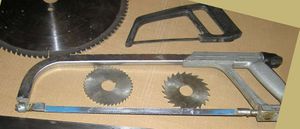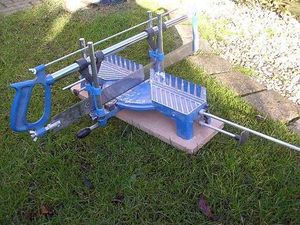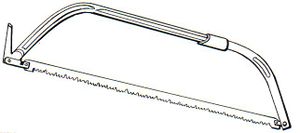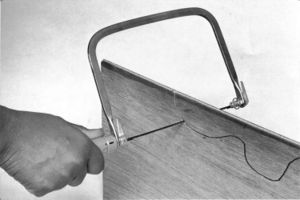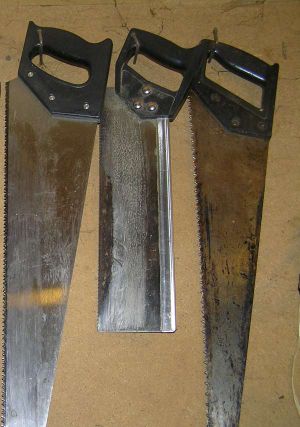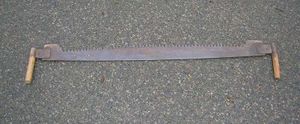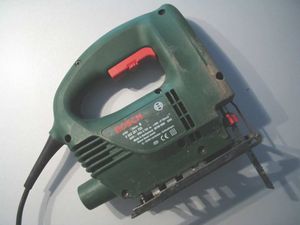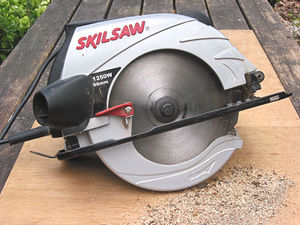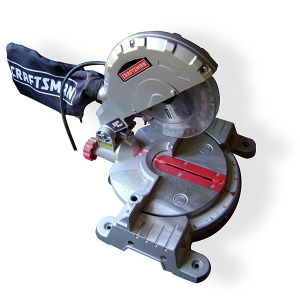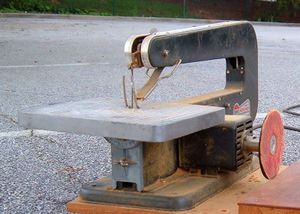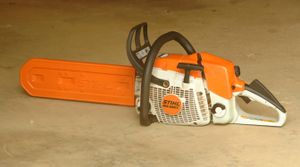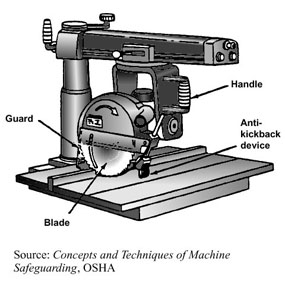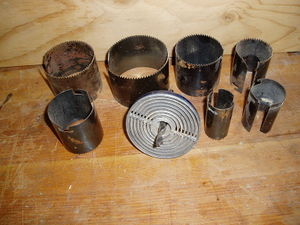Difference between revisions of "Saw"
Jump to navigation
Jump to search
| Line 51: | Line 51: | ||
===Pullsaw=== | ===Pullsaw=== | ||
| − | * | + | * Any saw that cuts on the pull stroke |
* Blade thinner than pushsaws | * Blade thinner than pushsaws | ||
* Less effort for given progress than pushsaws | * Less effort for given progress than pushsaws | ||
| + | * See Japanese saws | ||
===Fretsaw=== | ===Fretsaw=== | ||
Revision as of 23:41, 13 April 2009
Hand saws
Hacksaw
- 2 types:
- Junior hacksaw, 6" blades
- Bigger one, 12" blades & other sizes
Mitre Saw
- Wood is clamped to the base
- Frame guides saw blade, keeping it at the chosen angle
- Small captive handsaw of some type cuts the timber
- Quite different to the electric mitre saw
Jack Saw
- General purpose construction saw
- Cuts timber, aerated concrete etc
Toolbox Saw
- Shorter version of jack saw
- Fits in toolboxes
Floorboard Saw
File:Floorboard saw 603-4.jpg
Floorboard saw
- Has additional teeth on the top side in an arc near the end
- Can saw into floorboards in situ
Azebiki
- Japanese saw with teeth on an outward curve
- good for cutting floorboards
- pic
Bow Saw
- Sawing tree branches
- The coarse peg teeth usually used cut on both strokes
Backsaw
- Saws with reinforced back, such as tenon saw
Coping Saw
Crosscut Saw
Pullsaw
- Any saw that cuts on the pull stroke
- Blade thinner than pushsaws
- Less effort for given progress than pushsaws
- See Japanese saws
Fretsaw
Japanese Saws
- Several types are useful for DIY
- Japanese saws normally cut on the pull stroke, enabling use of thinner flexible blades. Less kerf means less physical work to achieve a given cut.
- Tend to cost much more than western style saws
Gents Saw
Keyhole Saw
- Very narrow blade for tight places
Tenon Saw
Two-man saw
- aka pit saw
- Long slightly curved blade with a handle on each end
- Double the sawing power
- Very long stroke
- About the only DIYer accessible saw that can cut whole mature trees into lengths
Wire saw
- Flexible saw wire with a handle on each end
- Mostly used for veterinary uses (bones, horns)
- Exceptionally good access properties for difficult cuts, can thread through and round things
- Not expensive
- Not stocked by many DIY tool suppliers
- Coils into a tiny size, one could carry 10 in a pocket easily
- A popular tool in survival kits due to tiny size
Power Saws
Jigsaw
- Low cutting speed
- Can cut curves
- Steer by rotating the saw, never push sideways
- Quality varies greatly
- Cheap & midrange jigsaws:
- Performance generally anything from patchy to dire
- Blades wander & bend badly
- Cost of ruined wood over the lifetime of a cheap or midrange jigsaw is likely to exceed the cost of a better saw
- Not possible to cut a straight line using a guide fence, as they need regular direction correction
- Good jigsaws:
- Constrain the blade with rollers
- Can cut straight lines
- Much less prone to blade bending, but not immune
- Various types of blade available:
- Coarse, medium, fine
- Blades for wood, metal, plastic, leather, paper products
- Flush cutting
- Knife
- Grit
- Varying teeth pitch
Circular saw
- Fast cutting
- Cuts straight lines only
- Good general purpose DIY saw
- Riving knife prevents kickback
- Blades with high number of teeth can produce very smooth cuts
- Normally supplied with a guide fence
- Depth of cut and angle can be preset
- Max possible cutting depth is reduced with angled cuts
- Hand held, bench type and cordless circular saws are all used for DIY
Mitre Saw
- Compound mitre saws' blades can swivel in 2 axes for compound angle cuts.
- Fast cutting
- Fairly small max cut width
- Hence mostly used for cross cutting
- Circular saw blade
- Cutting head swivels to cut at various angles
- Cutting head tilts to give cuts angled in 2 axes
- The quality of these machines varies widely
- Plastic bases found on budget machines bend slightly under force, misaligning cuts.
- On poor quality machines the saw head may be subject to some unwanted movement
- Pushing the saw can violently shatter the fence with some budget machines
- Cut width can be roughly doubled if the workpiece is turned over to complete the cut from the other side. The result is pretty good, but not perfect, if care is taken to get good alignment for the second half of the cut.
- Laser makes aligment of timber much quicker than running an eye across the blade
- See Mitre saw review
Sliding Mitre saw
- Mitre saw with cutting head that slides to cut wider timber
- Enables longer cuts to be made in larger timber
Flipsaw
- Mitre saw with a sawhead that flips over to give either a mitre saw or benchsaw
Cutoff Saw
- Look somewhat like mitre saws, but with no angle adjustments
- Cuts at precisely 90 degrees
- Workpiece clamp included
- Abrasive grit blade usually used
- Primarily used on metalwork
Scroll Saw
- Vibrating blade can be touched without injury
- Modern version of fretsaw
Spiral saw
- eg Rotozip
- Can plunge into solid materials then drill in any direction
- Can not withstand a lot of side force
- Limited uses due to poor performance with a lot of uses
- OK for very soft materials
- Die Grinders can use 1/8" spiral saw blades, but such thin blades are rather weak
- Spiral saws taking 1/8" blades also take die grinder accessories - check speed ratings
Table saw
- Circular blade
- Fast feed rate
- Plastic or wood pushers are used to keep hands away from blade
- Old table saws lack guarding
Bandsaw
- Uses a blade consisting of a continuous loop of spring steel, with cutting teeth on one edge. This rotates around two aligned wheels (one of them driven), and passes vertically through a cutting table.
- Coarse, fine and omnidirectional blades available
- A typical DIY bandsaw blade of 12mm width allows straight and curved cuts down to about 150mm radius to be comfortably made. Narrower blades allow tighter curves to be cut, but they are more vulnerable to breakage.
- For accuracy of cutting, the 'set' of the teeth on a bandsaw blade should be properly maintained. Once the 'set' has gone, the blade will tend to wander.
Handheld Bandsaw
- A miniature hand held version of a band saw (picture)
- Anyone used one?
Tile saw
- Small table saw with diamond grit circular tile blade
- Water cooled blade
- Makes very clean cuts in ceramic tile.
- Can cut small strips of tile neatly too
- Replacing the blade might allow it to do other jobs too
Reciprocating saw
- Powered version of jack saw or hacksaw
Chainsaw
- Relatively high risk saw
- Protective clothing is wise
- Basic training is wise
- Correct type of oil important
- Blade should not contact soil
- Tip must not touch workpiece, or the tool throws at the user
- Chainsaw art is becoming increasingly popular
Radial arm saw
Another type of sliding circular saw
Holesaw
File:Holesaw 455-2.jpg
Hole saw
- Coarse tooth holesaws cut wood & plastic, and some cut metals
- Abrasive core drills are used on masonry
- One type of holesaw is durable, the other type very weak and must be used with care
- See main article Holesaw
Reviews
To Do
Plywood saw Rip saw Saw set
